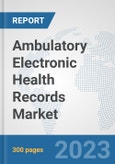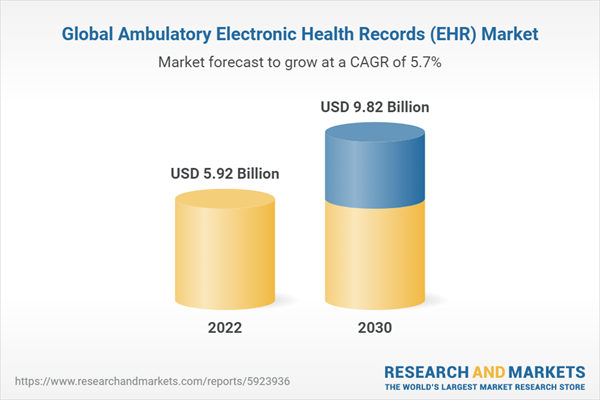The report on the global ambulatory Electronic Health Records (EHR) market provides qualitative and quantitative analysis for the period from 2021-2030. The global ambulatory Electronic Health Records (EHR) market was valued at USD 5.92 billion in 2022 and is expected to reach USD 9.82 billion in 2030, with a CAGR of a 5.72% during the forecast period 2023-2030. The study on ambulatory electronic health records (EHR) market covers the analysis of the leading geographies such as North America, Europe, Asia Pacific, and RoW for the period of 2021-2030.
Ambulatory Electronic Health Records (EHR) play a vital role in modern healthcare by digitizing and organizing patient health information in outpatient settings. These systems facilitate seamless data access for healthcare providers, improving patient care, and operational efficiency. Ambulatory EHRs store comprehensive medical data online, typically for non-hospitalized treatments and surgeries. Their portability makes monitoring health history and ongoing care more convenient for medical professionals. Physicians using this software generate extensive patient health record databases, enhancing their understanding of patient health for better diagnoses. The global ambulatory EHR market is on the rise, driven by increased adoption in developed regions, the demand for efficient healthcare data exchange, technological advancements, and government initiatives promoting patient health record portals. These systems have a significant role to play in the digital transformation of healthcare, ensuring more accessible, secure, and data-driven outpatient care.
The ambulatory EHR (Electronic Health Records) market is experiencing robust growth due to several interconnected factors. A significant driver is the increasing adoption of EHR solutions in developed markets, where healthcare providers are recognizing the benefits of digital health records in enhancing patient care and operational efficiency. Moreover, the ambulatory EHR market is propelled by a growing number of government initiatives and incentives designed to encourage the adoption of electronic health record systems. Government programs and regulatory measures, such as the Meaningful Use program in the United States, have offered financial incentives to healthcare providers as a means of encouraging them to adopt and effectively implement EHR systems. These governmental initiatives stimulate the adoption of EHR systems by providing financial incentives for compliance and imposing penalties for non-compliance. However, the substantial cost and financial burden associated with implementing these systems. Healthcare organizations, especially smaller and underfunded ones, often struggle with the high expenses of EHR adoption, including software licensing, hardware, training, and ongoing maintenance. These costs can strain budgets and divert resources from other critical healthcare needs. Furthermore, there are often unexpected expenses related to customization and ensuring compliance with ever-evolving healthcare regulations. This financial barrier can hinder the adoption of ambulatory EHR systems, particularly in regions or facilities with limited financial resources. Potential opportunities for the market include the integration of machine learning and deep learning technologies, along with evolving technological landscapes in emerging economies.
North America is the largest growing region for the global demand for portable EHR, with the United States leading the outpatient EHR market and projected to maintain its prominent position. This is driven by increasing government support for EHR systems and a growing patient preference for outpatient care over hospitalization. Moreover, The Asia-Pacific is expected to be the fastest-growing region during the forecast period, due to significant investments in EHR systems by government bodies, non-profit organizations, and the financial sector. The aging population and a rising incidence of chronic diseases are key factors propelling growth, especially in countries such as China and India. Additionally, the region benefits from an expanding network of medical professionals and outpatient healthcare services to a well-established hospital infrastructure and training programs.
1. Key Opinion Leaders associated
2. Internal and External subject matter experts
3. Professionals and participants from the industry
2. Product/brand/marketing managers
3. CXO level executives
4. Regional/zonal/ country managers
5. Vice President level executives.
2. Government/institutional publications
3. Trade and associations journals
4. Databases such as WTO, OECD, World Bank, and among others.
5. Websites and publications by research agencies
2. Complete coverage of all the segments in the ambulatory electronic health records (EHR) market to analyze the trends, developments in the global market and forecast of market size up to 2030.
3. Comprehensive analysis of the companies operating in the global ambulatory electronic health records (EHR) market. The company profile includes analysis of product portfolio, revenue, SWOT analysis and latest developments of the company.
4. Growth Matrix presents an analysis of the product segments and geographies that market players should focus to invest, consolidate, expand and/or diversify.
Ambulatory Electronic Health Records (EHR) play a vital role in modern healthcare by digitizing and organizing patient health information in outpatient settings. These systems facilitate seamless data access for healthcare providers, improving patient care, and operational efficiency. Ambulatory EHRs store comprehensive medical data online, typically for non-hospitalized treatments and surgeries. Their portability makes monitoring health history and ongoing care more convenient for medical professionals. Physicians using this software generate extensive patient health record databases, enhancing their understanding of patient health for better diagnoses. The global ambulatory EHR market is on the rise, driven by increased adoption in developed regions, the demand for efficient healthcare data exchange, technological advancements, and government initiatives promoting patient health record portals. These systems have a significant role to play in the digital transformation of healthcare, ensuring more accessible, secure, and data-driven outpatient care.
The ambulatory EHR (Electronic Health Records) market is experiencing robust growth due to several interconnected factors. A significant driver is the increasing adoption of EHR solutions in developed markets, where healthcare providers are recognizing the benefits of digital health records in enhancing patient care and operational efficiency. Moreover, the ambulatory EHR market is propelled by a growing number of government initiatives and incentives designed to encourage the adoption of electronic health record systems. Government programs and regulatory measures, such as the Meaningful Use program in the United States, have offered financial incentives to healthcare providers as a means of encouraging them to adopt and effectively implement EHR systems. These governmental initiatives stimulate the adoption of EHR systems by providing financial incentives for compliance and imposing penalties for non-compliance. However, the substantial cost and financial burden associated with implementing these systems. Healthcare organizations, especially smaller and underfunded ones, often struggle with the high expenses of EHR adoption, including software licensing, hardware, training, and ongoing maintenance. These costs can strain budgets and divert resources from other critical healthcare needs. Furthermore, there are often unexpected expenses related to customization and ensuring compliance with ever-evolving healthcare regulations. This financial barrier can hinder the adoption of ambulatory EHR systems, particularly in regions or facilities with limited financial resources. Potential opportunities for the market include the integration of machine learning and deep learning technologies, along with evolving technological landscapes in emerging economies.
North America is the largest growing region for the global demand for portable EHR, with the United States leading the outpatient EHR market and projected to maintain its prominent position. This is driven by increasing government support for EHR systems and a growing patient preference for outpatient care over hospitalization. Moreover, The Asia-Pacific is expected to be the fastest-growing region during the forecast period, due to significant investments in EHR systems by government bodies, non-profit organizations, and the financial sector. The aging population and a rising incidence of chronic diseases are key factors propelling growth, especially in countries such as China and India. Additionally, the region benefits from an expanding network of medical professionals and outpatient healthcare services to a well-established hospital infrastructure and training programs.
Report Findings
1) Drivers
- Increasing adoption of digital health records in enhancing patient care and operational efficiency drives the market growth.
- Increasing government initiatives and incentives increasing government initiatives and incentives for adopting EHR systems drive the ambulatory EHR market.
2) Restraints
- The substantial cost and financial burden associated with implementing ambulatory EHR systems acts as a restraint to the ambulatory EHR market.
3) Opportunities
- Potential opportunities for the market include the integration of machine learning and deep learning technologies.
Research Methodology
A) Primary Research
The primary research involves extensive interviews and analysis of the opinions provided by the primary respondents. The primary research starts with identifying and approaching the primary respondents, the primary respondents are approached include1. Key Opinion Leaders associated
2. Internal and External subject matter experts
3. Professionals and participants from the industry
The primary research respondents typically include
1. Executives working with leading companies in the market under review2. Product/brand/marketing managers
3. CXO level executives
4. Regional/zonal/ country managers
5. Vice President level executives.
B) Secondary Research
Secondary research involves extensive exploring through the secondary sources of information available in both the public domain and paid sources. Each research study is based on over 500 hours of secondary research accompanied by primary research. The information obtained through the secondary sources is validated through the crosscheck on various data sources.The secondary sources of the data typically include
1. Company reports and publications2. Government/institutional publications
3. Trade and associations journals
4. Databases such as WTO, OECD, World Bank, and among others.
5. Websites and publications by research agencies
Segment Covered
The global ambulatory electronic health records (EHR) market is segmented on the basis of deployment mode, practice size, application, and end user.The Global Ambulatory Electronic Health Records (EHR) Market by Deployment Mode
- Cloud-based Solutions
- On-premise Solutions
The Global Ambulatory Electronic Health Records (EHR) Market by Practice Size
- Small Practices
- Medium-sized Practices
- Large Practices
The Global Ambulatory Electronic Health Records (EHR) Market by Application
- Practice Management
- Patient Management
- E-prescribing
- Referral Management
- Population Health Management
- Other
The Global Ambulatory Electronic Health Records (EHR) Market by End User
- Hospital Owned Ambulatory Centers
- Independent Ambulatory Centers
Company Profiles
The companies covered in the report include- Allscripts healthcare solutions inc
- CompuGroup Medical US
- Athenahealth Inc.
- eClinicalWorks
- Oracle Corporation
- Medical Information Technology, Inc.
- Computer programs and systems
- Greenway Health, LLC
- Modernizing medicine
- Advanced Data Systems
What does this Report Deliver?
1. Comprehensive analysis of the global as well as regional markets of the ambulatory electronic health records (EHR) market.2. Complete coverage of all the segments in the ambulatory electronic health records (EHR) market to analyze the trends, developments in the global market and forecast of market size up to 2030.
3. Comprehensive analysis of the companies operating in the global ambulatory electronic health records (EHR) market. The company profile includes analysis of product portfolio, revenue, SWOT analysis and latest developments of the company.
4. Growth Matrix presents an analysis of the product segments and geographies that market players should focus to invest, consolidate, expand and/or diversify.
Table of Contents
Chapter 1. Preface
Chapter 2. Executive Summary
Chapter 3. Global Ambulatory Electronic Health Records (EHR) Market Overview
Chapter 5. Company Profiles and Competitive Landscape
Chapter 6. Global Ambulatory Electronic Health Records (EHR) Market by Deployment Mode
Chapter 7. Global Ambulatory Electronic Health Records (EHR) Market by Practice Size
Chapter 8. Global Ambulatory Electronic Health Records (EHR) Market by Application
Chapter 9. Global Ambulatory Electronic Health Records (EHR) Market by End User
Chapter 10. Global Ambulatory Electronic Health Records (EHR) Market by Region 2023-2030
Companies Mentioned
- Allscripts healthcare solutions inc
- CompuGroup Medical US
- Athenahealth Inc.
- eClinicalWorks
- Oracle Corporation
- Medical Information Technology, Inc.
- Computer programs and systems
- Greenway Health, LLC
- Modernizing medicine
- Advanced Data Systems
Table Information
| Report Attribute | Details |
|---|---|
| No. of Pages | 300 |
| Published | December 2023 |
| Forecast Period | 2022 - 2030 |
| Estimated Market Value ( USD | $ 5.92 Billion |
| Forecasted Market Value ( USD | $ 9.82 Billion |
| Compound Annual Growth Rate | 5.7% |
| Regions Covered | Global |
| No. of Companies Mentioned | 10 |









